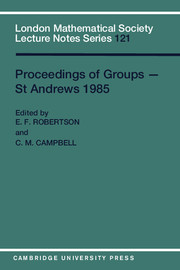Book contents
- Frontmatter
- Contents
- Introduction
- Photograph
- 1 Automorphisms of solvable groups, Part I
- 2 Automorphisms of solvable groups, Part II
- 3 A survey of groups with a single defining relation
- 4 Some algorithms for computing with finite permutation groups
- 5 Five lectures on group rings
- 6 Buildings and group amalgamations
- 7 Finite presentability of S-arithmetic groups
- 8 Efficient presentations of GL(2, ℤ) and PGL(2, ℤ)
- 9 The commutator map
- 10 Polynomial functions and representations
- 11 On questions of Brauer and Feit
- 12 The Picard group and the modular group
- 13 Factor groups of the lower central series of free products of finitely generated abelian groups
- 14 Lattice ordered groups - a very biased survey
- 15 Totally orthogonal finite groups
- 16 One-relator products of groups
- 17 The Cavicchioli groups are pairwise non-isomorphic
- 18 Congruence and non-congruence subgroups of the modular group: a survey
- 19 Small cancellation theory with non-homogeneous geometrical conditions and application to certain Artin groups
- 20 The Lie algebra associated to the lower central series of a group
- 21 Algebraically closed locally finite groups
- 22 On power-commutative and commutation transitive groups
- 23 Dimension function for discrete groups
- 24 Coset graphs
- 25 Nilpotent quotient algorithms
- 26 Generators of p-groups
- 27 On the matrix groups associated to the isometries of the hyperbolic plane
- 28 A characteristic subgroup of N-stable groups
- 29 The isomorphism problem for integral group rings of finite nilpotent groups
- 30 Embedding the root group geometry of 2F4(q)
- 31 On generalized Frobenius complements
- 32 Subgroups of finite index in soluble groups: I
- 33 Subgroups of finite index in soluble groups: II
- 34 Some interconnections between group theory and logic
- 35 Groups covered by abelian subgroups
- 36 Embeddings of infinite permutation groups
- 37 Maximal subgroups of sporadic groups
12 - The Picard group and the modular group
Published online by Cambridge University Press: 05 March 2012
- Frontmatter
- Contents
- Introduction
- Photograph
- 1 Automorphisms of solvable groups, Part I
- 2 Automorphisms of solvable groups, Part II
- 3 A survey of groups with a single defining relation
- 4 Some algorithms for computing with finite permutation groups
- 5 Five lectures on group rings
- 6 Buildings and group amalgamations
- 7 Finite presentability of S-arithmetic groups
- 8 Efficient presentations of GL(2, ℤ) and PGL(2, ℤ)
- 9 The commutator map
- 10 Polynomial functions and representations
- 11 On questions of Brauer and Feit
- 12 The Picard group and the modular group
- 13 Factor groups of the lower central series of free products of finitely generated abelian groups
- 14 Lattice ordered groups - a very biased survey
- 15 Totally orthogonal finite groups
- 16 One-relator products of groups
- 17 The Cavicchioli groups are pairwise non-isomorphic
- 18 Congruence and non-congruence subgroups of the modular group: a survey
- 19 Small cancellation theory with non-homogeneous geometrical conditions and application to certain Artin groups
- 20 The Lie algebra associated to the lower central series of a group
- 21 Algebraically closed locally finite groups
- 22 On power-commutative and commutation transitive groups
- 23 Dimension function for discrete groups
- 24 Coset graphs
- 25 Nilpotent quotient algorithms
- 26 Generators of p-groups
- 27 On the matrix groups associated to the isometries of the hyperbolic plane
- 28 A characteristic subgroup of N-stable groups
- 29 The isomorphism problem for integral group rings of finite nilpotent groups
- 30 Embedding the root group geometry of 2F4(q)
- 31 On generalized Frobenius complements
- 32 Subgroups of finite index in soluble groups: I
- 33 Subgroups of finite index in soluble groups: II
- 34 Some interconnections between group theory and logic
- 35 Groups covered by abelian subgroups
- 36 Embeddings of infinite permutation groups
- 37 Maximal subgroups of sporadic groups
Summary
1. The classical modular group M is PSL2(ℤ) the 2 x 2 projective special linear group with integral entries. The modular group has been one of the most extensively studied single groups (see references). The reason for this is that M arises in so many different contexts - number theory, group theory, automorphic function theory, Riemann surfaces and elsewhere. Each of these disciplines claims the modular group for its own and looks at it in a slightly different manner. Related to M is its cousin the Pioard group T which is PSL2(ℤ[i]), the projective special linear group with Gaussian integer entries. Г has also been extensively studied (references) although the work more recent. Group theoretically r is quite similar to H [10]. However Г and M differ greatly in their action on the complex plane. Whereas M is a Fuchsian group, r is nowhere discontinuous in C and therefore has no Fuchsian subgroups of finite index [23].
What we will do in this survey is compare and contrast Г and M in four different areas - group theoretical structure, general subgroup structure, congruence subgroups and Fuchsian subgroups. As a general rule of thumb group theoretical properties of M will have close analogs in Г. As might be expected given the number theoretical similarities of ℤ and ℤ[i], the closer the group theoretical property reflects the underlying number theory (i.e., congruence subgroups) the closer the analog. Properties involving discontinuity however must be considerably revised.
- Type
- Chapter
- Information
- Proceedings of Groups - St. Andrews 1985 , pp. 150 - 163Publisher: Cambridge University PressPrint publication year: 1987



